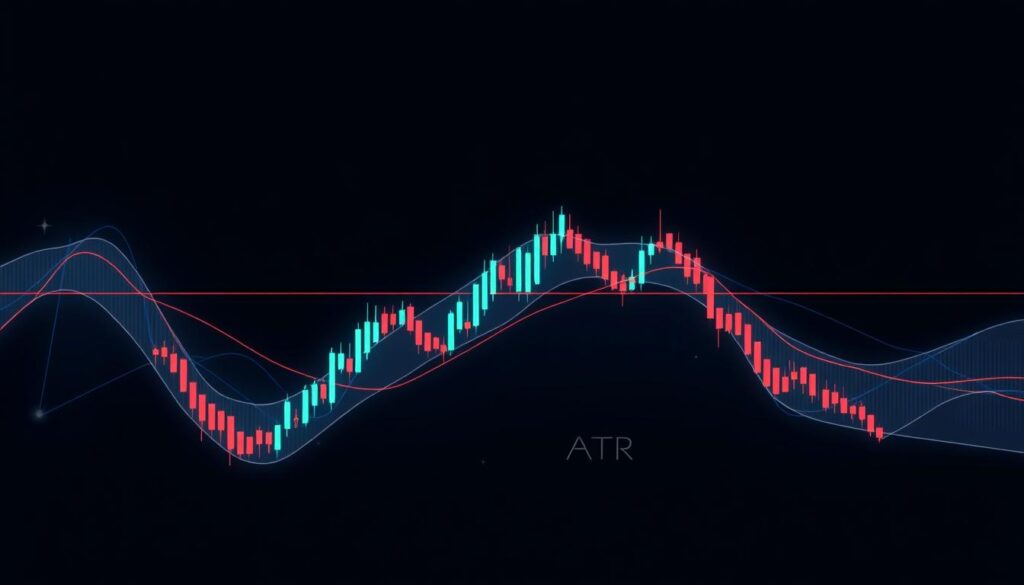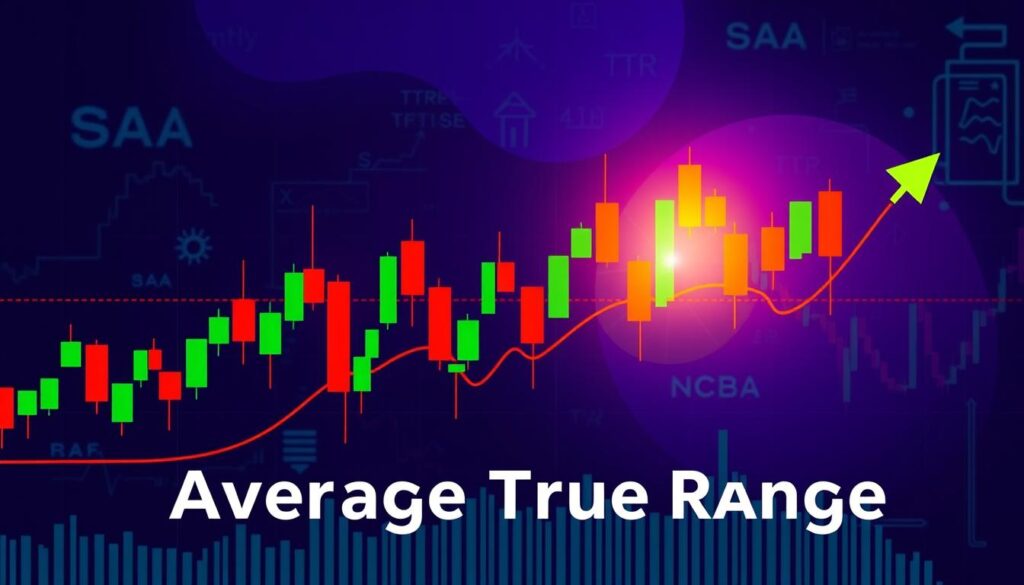The Average True Range (ATR) is a powerful technical analysis tool developed by J. Welles Wilder Jr. to measure market volatility. Unlike other indicators that focus on price direction, the ATR solely measures the degree of price movement, making it an essential component of many traders’ risk management strategies. The ATR indicator is a volatility measurement tool that helps traders understand the market’s price movement, and it is commonly used as a trading tool to set stop-loss orders and determine position sizes.
The ATR can be applied effectively across various financial markets, such as forex, stocks, indices, and commodities, aiding in setting stop-loss levels and determining position sizes based on the asset’s volatility. By incorporating the ATR into trading strategies, traders can reduce emotional decision-making, tailor risk management, adapt to market conditions, and improve trading consistency. The ATR indicator is usually calculated over 14 periods, but this period can be adjusted based on trader preferences and the asset being analyzed.
Table of Contents
Key Takeaways
- The ATR is a powerful technical analysis tool for measuring market volatility.
- The ATR indicator is commonly used as a trading tool to set stop-loss orders and determine position sizes.
- The ATR can be applied effectively across various financial markets, such as forex, stocks, indices, and commodities.
- By incorporating the ATR into trading strategies, traders can reduce emotional decision-making and improve trading consistency.
- The ATR indicator is usually calculated over 14 periods, but this period can be adjusted based on trader preferences and the asset being analyzed.
- The ATR can be combined with other technical indicators to enhance trading strategies and analyze market trends.
Understanding the Average True Range in Trading
The Average True Range (ATR) is a technical analysis tool used to measure market volatility. Developed by J. Welles Wilder, it has become a crucial component of many trading strategies. ATR is calculated based on the average range of an asset’s price over a specified period, typically 14 days. This indicator helps traders understand the volatility of a market and make informed decisions about their trades.
ATR is an essential tool for traders, as it provides valuable insights into an asset’s price movements. By analyzing market volatility, traders can identify potential trading opportunities and adjust their strategies accordingly. The ATR indicator is also useful for setting stop-loss levels and determining the size of a trade. As Welles Wilder noted, ATR is a self-adjusting risk limit that depends on market volatility, making it an essential component of position sizing in financial trading.
Some key points to consider when using ATR in technical analysis include:
- High ATR values indicate high market volatility, while low ATR values signify low price variations.
- ATR can be used to track abnormal price movements and identify potential trading opportunities.
- The multiple of ATR, such as 1.5 times the ATR value, can be employed to track abnormal price movements.
By incorporating ATR into their trading strategies, traders can gain a better understanding of market volatility and make more informed decisions about their trades. As a tool for technical analysis, ATR has become an essential component of many trading strategies, and its applications continue to evolve with the changing markets.
| ATR Value | Market Volatility | Trading Strategy |
|---|---|---|
| High | High | Adjust stop-loss levels and trade size |
| Low | Low | Consider alternative trading strategies |
The Mathematical Foundation of ATR
The Average True Range (ATR) is a widely used indicator in trading, and its mathematical foundation is based on the true range calculation. This calculation involves finding the maximum value among the current high minus the current low, the absolute value of the current high minus the previous close, and the absolute value of the current low minus the previous close. The volatility formula used in ATR is a key component in understanding market price movement.
To calculate the ATR, traders typically use a 14-day period, as suggested by J. Welles Wilder Jr. The ATR formula involves calculating the true range for each day and then finding the average of these values over the specified period. This results in a smoothed measurement of market volatility, which can be used to set stop-loss levels and make informed trading decisions.
- ATR is a lagging indicator, meaning it reflects historical volatility data.
- ATR can be used to set stop-loss levels and limit potential losses.
- ATR can be combined with other technical indicators to enhance trading strategies.
By understanding the mathematical foundation of ATR, traders can better utilize this indicator to make informed trading decisions and manage risk. Thetrue range calculationandvolatility formulaused in ATR provide valuable insights into marketprice movement, allowing traders to adjust their strategies accordingly.
Key Components of ATR Calculation
The Average True Range (ATR) is a crucial indicator used in market analysis to measure volatility. It is calculated as the average of true ranges over a specified period, typically based on 14 periods. The true range is the greatest of three values: current high minus the current low, absolute value of the current high minus the previous close, and absolute value of the previous close minus the current low. This calculation helps traders understand price ranges and volatility measurement.
In market analysis, ATR is used to determine the price ranges and volatility measurement of a particular asset. By analyzing the ATR, traders can identify periods of high or low volatility, which can inform their trading decisions. For example, a high ATR value may indicate a period of high volatility, while a low ATR value may indicate a period of low volatility.
True Range Formulas
The true range formula is used to calculate the true range for each period. The formula is: True Range = Maximum of (Current High – Current Low, Absolute Value of (Current High – Previous Close), Absolute Value of (Current Low – Previous Close)). This formula helps traders understand the price movement and volatility measurement of an asset.
Smoothing Periods
The smoothing period is the number of periods used to calculate the ATR. A shorter smoothing period, such as 2-10 periods, is used to measure recent volatility, while a longer smoothing period, such as 20-50 periods, is used to measure longer-term volatility. The choice of smoothing period depends on the trader’s goals and market analysis requirements.
Time Frame Considerations
The time frame used to calculate the ATR can significantly impact the results. Traders can use different time frames, such as intraday, daily, weekly, or monthly, to analyze the ATR. The choice of time frame depends on the trader’s goals and market analysis requirements. For example, a day trader may use a shorter time frame, such as 1-5 minutes, to analyze the ATR, while a long-term investor may use a longer time frame, such as daily or weekly.
| Time Frame | ATR Calculation |
|---|---|
| Intraday | Calculated using 1-5 minute intervals |
| Daily | Calculated using daily high and low prices |
| Weekly | Calculated using weekly high and low prices |
| Monthly | Calculated using monthly high and low prices |
How ATR Measures Market Volatility
The Average True Range (ATR) is a volatility indicator that measures price fluctuations in a market. It helps traders understand the degree of price fluctuations and make informed decisions. Higher ATR values indicate increased volatility, suggesting that prices are moving more dramatically. Conversely, lower ATR values suggest decreased volatility and more stable price action.
ATR values tend to be higher for more volatile assets and lower for less volatile ones. This makes ATR a useful tool for comparing market trends across different assets and time frames. By analyzing ATR values, traders can gain valuable insights into price fluctuations and make more accurate predictions about future market movements.
Some key points to consider when using ATR to measure market volatility include:
- ATR values can be used to set stop-loss and take-profit levels based on market volatility.
- ATR can be combined with other technical analysis tools to enhance trading decisions.
- ATR is an indicator used in any conditions, for measuring volatility, and evaluating trading opportunities.
By understanding how ATR measures market volatility, traders can develop more effective trading strategies and make more informed decisions. ATR is a powerful tool that can help traders navigate complex market trends and make the most of price fluctuations.
Implementing ATR in Your Trading Strategy
When it comes to incorporating the Average True Range (ATR) into your trading strategy, it’s essential to understand how to set up ATR indicators and choose the right parameters. Several online trading platforms, such as IG trading platform and app, MetaTrader 4 (MT4), and ProRealTime, offer the ability to overlay the ATR onto trading charts, making it easy to track volatility in an underlying market without manual calculations.
Using technical analysis tools like ATR can help traders make informed decisions. The ATR settings can be adjusted to suit different trading styles and market conditions. For example, a shorter ATR period may be more suitable for day trading, while a longer period may be more suitable for long-term investing.
Setting Up ATR Indicators
To set up ATR indicators on your chosen trading platforms, you’ll typically need to follow these steps:
- Open your trading platform and navigate to the indicator settings.
- Select the ATR indicator and choose your desired parameters, such as the period and ATR settings.
- Apply the indicator to your trading chart and adjust as needed.
Choosing the Right Parameters
Choosing the right parameters for your ATR indicator is crucial. Consider the following factors when selecting your ATR settings:
| Parameter | Description |
|---|---|
| Period | The number of days used to calculate the ATR. |
| Multiplier | The multiplier used to calculate the ATR value. |
By understanding how to implement ATR in your trading strategy and choosing the right parameters, you can make more informed trading decisions and potentially improve your trading results.
Position Sizing with ATR
The Average True Range (ATR) indicator is a valuable tool for determining position sizes, ensuring trades align with your risk management strategy. To use ATR in position sizing, follow these steps:
First, determine the cash amount you’re willing to risk per trade. This is a crucial step in risk management, as it helps you avoid over-leveraging your portfolio. Next, calculate the per-unit risk using the ATR. This will give you an idea of the potential price fluctuations for the asset. Finally, divide your cash risk by the per-unit risk to determine the optimal position size.
This approach to trade sizing is based on volatility-based positioning, which takes into account the asset’s potential price fluctuations. By using ATR to inform your position sizing decisions, you can better manage your risk and maximize your potential returns. For example, if you have a $10,000 portfolio with a 1% risk tolerance, you may choose to risk $100 per trade. Using the ATR, you can calculate the optimal position size based on the asset’s volatility.
- Determine your cash risk: $100
- Calculate the per-unit risk using ATR: $0.76
- Divide your cash risk by the per-unit risk: 100 / 0.76 = 131.58 shares
By using ATR to inform your position sizing decisions, you can create a more effective risk management strategy and improve your overall trading performance.
Using ATR for Stop Loss Placement
When it comes to setting stop loss orders, traders often rely on the Average True Range (ATR) to determine the optimal placement. The ATR measures market volatility, providing a gauge of how much an asset is likely to move in a given period. By using the ATR, traders can set stop loss orders that are tailored to the current market conditions, helping to mitigate risk and protect their trades.
To set a stop-loss using the ATR, traders typically use the following formulas: For long positions, the stop loss is set at the entry price minus the ATR multiplied by a multiplier, while for short positions, the stop loss is set at the entry price plus the ATR multiplied by a multiplier. The multiplier is a personal choice based on risk tolerance, with common values ranging from 1.5 to 3. This approach allows traders to adjust their stop loss orders according to the current market volatility, ensuring that their trades are protected from excessive losses.
Dynamic Stop Loss Methods
One of the key benefits of using the ATR for stop loss placement is that it allows for dynamic stop loss methods. This means that the stop loss orders can be adjusted in real-time to reflect changes in market volatility, providing a more effective form of trade protection. By using the ATR, traders can set stop loss orders that are tailored to the current market conditions, helping to minimize losses and maximize gains.
Some common methods for setting stop loss orders using the ATR include:
- Fixed-multiple method: This involves setting the stop loss order at a fixed multiple of the ATR, such as 2 or 3 times the ATR.
- Trailing stop method: This involves setting the stop loss order at a certain percentage of the ATR, such as 10% or 20%.
These methods can be used in conjunction with other forms of risk mitigation, such as position sizing and trade management, to provide a comprehensive approach to trade protection.
Risk Management Applications
The ATR can also be used in a variety of risk management applications, including:
| Application | Description |
|---|---|
| Stop loss placement | Using the ATR to set stop loss orders that are tailored to the current market conditions. |
| Position sizing | Using the ATR to determine the optimal position size based on the current market volatility. |
| Trade management | Using the ATR to manage trades and adjust stop loss orders in real-time. |
By using the ATR in these applications, traders can gain a better understanding of market volatility and make more informed decisions about their trades, ultimately helping to mitigate risk and protect their investments.
ATR Trading Strategies for Different Markets
The Average True Range (ATR) indicator is a versatile tool that can be applied to various financial markets, including forex trading, stock market, and cryptocurrency volatility. Traders can use ATR to develop strategies for different markets, taking into account the unique characteristics of each market.
For example, in forex trading, ATR can be used to measure the volatility of currency pairs, helping traders to set stop-loss levels and adjust their position sizes. In the stock market, ATR can be used to identify stocks with high volatility, which can be attractive to traders looking for opportunities to profit from price movements.
In the context of cryptocurrency volatility, ATR can be used to measure the volatility of cryptocurrencies such as Bitcoin and Ethereum, helping traders to navigate the highly volatile cryptocurrency market. By using ATR in combination with other indicators, traders can develop effective trading strategies for different markets.
- Adjusting the ATR period to suit the market’s volatility
- Using ATR in combination with other indicators to confirm trading signals
- Monitoring ATR values to identify changes in market volatility
By understanding how to apply ATR to different markets, traders can develop a range of trading strategies that take into account the unique characteristics of each market. Whether trading in forex, stocks, or cryptocurrencies, ATR can be a valuable tool for measuring volatility and making informed trading decisions.
| Market | ATR Application |
|---|---|
| Forex | Measuring currency pair volatility |
| Stock Market | Identifying high-volatility stocks |
| Cryptocurrency | Measuring cryptocurrency volatility |
Common Mistakes When Using ATR
When utilizing the Average True Range (ATR) indicator, traders often fall into common pitfalls that can hinder their trading performance. One of the primary mistakes is volatility misinterpretation, where traders assume that ATR measures the direction of price movements rather than their intensity. This misconception can lead to trading errors, as traders may misinterpret the market’s volatility and make incorrect decisions.
Another mistake traders make is ATR misuse, where they fail to adjust the ATR settings according to the market conditions. This can result in inappropriate stop-loss levels, leading to unnecessary losses. To avoid these mistakes, traders must understand that ATR is a measure of market volatility, not trend direction. By recognizing these common pitfalls, traders can refine their trading strategies and avoid costly trading errors.
Some common mistakes to watch out for include:
- Confusing ATR with price direction
- Misunderstanding the absolute value nature of ATR
- Using inappropriate time frames for ATR calculation
- Failing to adjust ATR-based strategies for different market conditions
By being aware of these potential pitfalls, traders can optimize their use of ATR and make more informed trading decisions, ultimately reducing the likelihood of trading errors and improving their overall trading performance.
| Mistake | Consequence |
|---|---|
| Volatility misinterpretation | Incorrect trading decisions |
| ATR misuse | Inappropriate stop-loss levels |
| Incorrect time frame | Inaccurate ATR values |
Advanced ATR Techniques
Traders can take their trading strategies to the next level by incorporating advanced ATR techniques into their technical analysis. This involves using indicator combinations to gain a more comprehensive view of market volatility. By combining ATR with other indicators like moving averages or relative strength index (RSI), traders can create more robust analysis and make informed decisions.
One approach to advanced trading strategies is to use multiple time frame analysis with ATR. This involves applying ATR to different time frames, such as hourly, daily, or weekly charts, to identify trends and patterns. By analyzing ATR across multiple time frames, traders can gain a better understanding of market volatility and make more accurate predictions.
Some popular indicators that can be combined with ATR include:
- Moving Averages
- Relative Strength Index (RSI)
- Bollinger Bands
- Keltner Channels
These indicator combinations can help traders identify potential breakout points, confirm entry and exit points, and adjust their trading strategies accordingly.
By incorporating advanced ATR techniques into their trading strategies, traders can improve their technical analysis and make more informed decisions. This can lead to more effective risk management and increased trading success.
| Indicator | Description |
|---|---|
| Moving Averages | A trend-following indicator that helps identify the direction of the market |
| Relative Strength Index (RSI) | A momentum indicator that helps identify overbought and oversold conditions |
| Bollinger Bands | A volatility indicator that helps identify potential breakout points |
| Keltner Channels | A volatility indicator that helps identify potential trend reversals |
Real-World Trading Examples with ATR
When it comes to applying the Average True Range (ATR) indicator in real-world trading scenarios, trading apps can provide valuable insights. By examining case studies of successful trades, traders can gain a deeper understanding of how ATR application can inform entry points, stop loss placement, and position sizing decisions.
In various trading scenarios, ATR can be used to measure market volatility and determine the potential for trend reversals. For instance, increased ATR values can indicate higher volatility, while decreased ATR values can suggest lower volatility. By analyzing these values, traders can make more informed decisions about their trades.
Some common trading scenarios where ATR application is particularly useful include:
- Breakout trades, where ATR can help determine the potential for a trend reversal
- Retracement trades, where ATR can inform stop loss placement and position sizing decisions
- Range-bound trades, where ATR can help determine the potential for a breakout or breakdown
By incorporating ATR into their trading strategy, traders can gain a competitive edge in the market. Whether it’s through analyzing case studies or applying ATR in real-time trading scenarios, this indicator can provide valuable insights into market volatility and trend reversals.
| Trading Scenario | ATR Application |
|---|---|
| Breakout trades | Determine potential for trend reversal |
| Retracement trades | Inform stop loss placement and position sizing decisions |
| Range-bound trades | Determine potential for breakout or breakdown |
ATR in Different Market Conditions
Understanding how Average True Range (ATR) applies to various market conditions is crucial for traders. ATR is a volatility indicator that can help traders gauge market trends and make informed decisions. By analyzing volatility analysis with ATR, traders can identify potential trading opportunities and manage risk effectively.
In a bull market, ATR can be used for trend confirmation and pullback trades. Traders can utilize adaptive trading strategies to adjust their positions based on changing market conditions. In a bear market, ATR can be used for short selling and risk management in downtrends. For sideways markets, ATR can help identify potential breakouts and manage trades in range-bound conditions.
Some key considerations for using ATR in different market conditions include:
- Adjusting the ATR parameters to suit the market conditions
- Using ATR in combination with other indicators for confirmation
- Monitoring market trends and adjusting the trading strategy accordingly
By incorporating ATR into their trading strategy, traders can improve their volatility analysis and make more informed decisions. With the ability to adapt to changing market conditions, traders can develop an adaptive trading approach that helps them navigate various market environments.
| Market Condition | ATR Application |
|---|---|
| Bull Market | Trend confirmation and pullback trades |
| Bear Market | Short selling and risk management |
| Sideways Market | Identifying potential breakouts and managing trades |
Optimizing Your ATR Settings
When it comes to optimizing your Average True Range (ATR) settings, parameter tuning is crucial for achieving the best trading performance. This involves adjusting the period and multiplier to suit your trading style and the specific asset being analyzed. For example, a shorter time frame, such as hours, may require a lower period, between 2 to 10, while a longer time frame, such as weeks or months, may require a higher period, between 20 to 50.
To determine the optimal ATR settings, backtesting is essential. This involves testing different ATR settings on historical data to evaluate their effectiveness in various market conditions. By doing so, traders can identify the settings that yield the best trading performance and adjust their strategy accordingly.
Some key considerations for optimizing ATR settings include:
- Time frame: The time frame used for ATR calculation can significantly impact trading performance. A shorter time frame may be more suitable for day trading, while a longer time frame may be more suitable for swing trading.
- Multiplier: The multiplier used for ATR calculation can also impact trading performance. A higher multiplier may be more suitable for volatile markets, while a lower multiplier may be more suitable for less volatile markets.
- Asset: The specific asset being traded can also impact ATR settings. For example, a highly volatile asset may require a higher period and multiplier, while a less volatile asset may require a lower period and multiplier.
By carefully considering these factors and using backtesting to evaluate different ATR settings, traders can optimize their ATR settings for improved trading performance. This can help them make more informed decisions and achieve their trading goals.
Optimizing ATR settings is an ongoing process that requires continuous monitoring and adjustment. By staying up-to-date with market conditions and adjusting ATR settings accordingly, traders can stay ahead of the curve and achieve their trading goals.
| Time Frame | Period | Multiplier |
|---|---|---|
| Hours | 2-10 | 1-2 |
| Days | 14-20 | 2-3 |
| Weeks | 20-50 | 3-5 |
Conclusion
As we conclude our exploration of the Average True Range (ATR) indicator, it’s clear that this powerful tool can be the key to trading success, risk management, and insightful market analysis. By understanding the mathematical foundations and practical applications of ATR, traders can make more informed decisions, effectively manage their positions, and adapt to various market conditions.
Whether you’re a novice or an experienced trader, incorporating ATR into your trading strategy can significantly enhance your performance. From setting appropriate stop-loss levels to determining optimal position sizes, ATR provides valuable insights into an asset’s volatility, allowing you to align your risk exposure with your trading objectives.
Remember, the journey to trading mastery is an ongoing process of practice, experimentation, and continuous learning. By embracing ATR and its nuances, you’ll unlock new opportunities to navigate the markets with confidence and precision. Embark on this voyage of trading excellence, and let ATR be your trusted companion in achieving sustainable trading success.
FAQ
What is the Average True Range (ATR)?
The Average True Range (ATR) is a technical analysis indicator that measures market volatility by calculating the average of the absolute values of the differences between the current period’s highest and lowest prices and the previous period’s closing price.
How does ATR differ from other volatility indicators?
ATR focuses on price movement rather than price direction, making it a valuable tool for analyzing market volatility regardless of whether the market is trending up, down, or sideways.
What are the key benefits of using ATR in trading?
ATR can be used to enhance trading strategies, improve risk management, and provide valuable insights into market conditions across various financial markets and timeframes.
How is the ATR calculated?
The ATR is calculated by taking the average of the absolute values of the differences between the current period’s high and low, and the previous period’s close. This process is repeated over a specified number of periods, typically 14 days, to calculate the Average True Range.
What are the key components of the ATR calculation?
The ATR calculation involves the true range formula, which considers the maximum of the current period’s high and low and the previous period’s close. The true range values are then smoothed using an exponential moving average to produce the final ATR reading.
How can ATR be used to measure market volatility?
ATR provides a quantitative measure of market volatility by reflecting the average magnitude of price changes over a given time period. Higher ATR values indicate increased volatility, while lower ATR values suggest more stable market conditions.
What are some common mistakes traders make when using ATR?
Frequent mistakes include confusing ATR with price direction, using inappropriate time frames, and failing to adjust ATR-based strategies for different market conditions. Understanding these potential pitfalls can help traders use ATR more effectively in their trading decisions.
How can ATR be combined with other technical indicators?
ATR can be effectively combined with other technical indicators, such as moving averages, RSI, Bollinger Bands, and Keltner Channels, to create more sophisticated trading systems that leverage the strengths of multiple analytical tools.
How can ATR be used to optimize position sizing and stop loss placement?
ATR can be used to determine appropriate position sizes based on market volatility and to set dynamic stop loss orders that adapt to changing market conditions, enhancing overall risk management in trading strategies.
How can traders adjust their ATR-based strategies for different market conditions?
Traders can adapt their ATR-based strategies to different market conditions, such as bull markets, bear markets, and sideways markets, by adjusting their parameter settings and focusing on the specific applications of ATR in each market environment.









